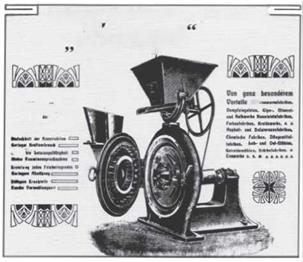A “soft size reduction” mill named the Triumph mill was made by Alpine in 1898 for preparing foodstuffs, animal fodder, and chemicals. The pin mill used the same principle as the colloid mill but with a lower speed of rotation. Figure 8.5 is the front page of the 1903 sales brochure.
This was the first of Alpine’s pin mills, which were known as the Perplex line of mills. The 1903 Alpine patent described the mill “as a centrifugal mill with a multi-performance, stationary, grate-like perforated centrifugal ring located between the pin beaters arranged on a rotating beater disc” (Gelberg and Lange 1998).
 FIGURE 8.4 High-speed colloid mill (Travis 1929)
FIGURE 8.4 High-speed colloid mill (Travis 1929)
Universal-Zerkleinerungs-Maschine I
Vorzuqe
Triumph-fflaldilm
Alpine started as a small workshop in 1886 when an iron turner, Otto Holzhauer, began to make tools in a small mechanical workshop in Augsburg, Germany. He was said to have had an unbridled love of experimentation, and by 1900 he had a wide product range that included steam rollers, crushers, brackets for balloons, elevators, bottle filling and rinsing systems, and dryers. Financial problems arose in maintaining this wide product range, as a result of which Hugo Sachs became an investor in the company in 1902 and an owner in 1916. Holzhauer may have failed as a businessman, but he has a place in the history of size reduction because of his use of rotating pins and intense turbulence to disperse and break particles in a size-reduction machine. Alpine’s Perplex mills were very successful with more than 17,000 being sold during the next 30 years. Size reduction in these mills involved two mechanisms: shredding and intense turbulence, which caused disintegration by dispersion. The original Triumph mill was designed to work as a shredder, but within a short time it was being used to grind materials that could either be shredded or shattered easily such as “cereals and grains of all types…and…a great
variety of products such as ammonia salt, saltpetre, sulphur, cork, coffee, cocoa, glass, rubber, coal, leather waste, paper and sugar” (Gelberg and Lange 1998).
The pin beater mill made by Holzhauer in 1898 proved to be a versatile machine for general fine-grinding purposes, and they are now produced by many manufacturers. Some of the industries in which they are used are
■ Chemical
■ Pharmaceutical
■ Animal feed
■ Herb, spice, food, and confectionery
■ Mineral powders, wood, and chipboard
■ Plastics
■ Ink and paint
The mills can be operated to produce various particle sizes, for example, less than 20 pm for pigments and pesticides to 150-500 pm for spices.
Finer grinding is obtained in pin mills by using higher speeds, the product size controlled by the speed differential between the rotating discs that contain the pins. Figure 8.6 shows a mill with pin discs. The counter-rotating discs containing the pins in the housing and door are driven by separate motors. Table 8.1 gives the operating conditions for a large high-speed pin mill of the type shown in Figure 8.6.
